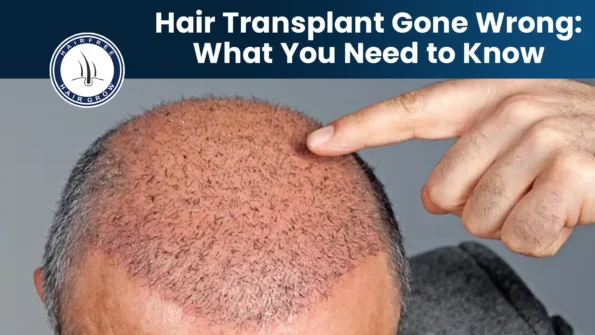Hair transplant surgery is known as one of the most effective ways to correct hair loss. With just one advanced procedure, your entire scalp can be restored.
However, the rise of illegal, black-market clinics has made hair transplant gone wrong a real issue. Attracted by the promise of great results at lower prices, many patients end up with scarring, infections, and poor outcomes.
If you’re considering a hair transplant, how can you ensure that the clinic you choose is legitimate? And how can you tell if you’ve received poor treatment? We’re here to help with that.
Understanding Hair Transplantation
Hair transplantation is a procedure used to treat hair loss or thinning hair. It involves moving hair follicles from one part of the scalp (the donor area) to another part where hair is thinning or has been lost (the recipient area). There are two main techniques used for hair transplantation:
Follicular Unit Transplantation (FUT)
- In this method, a strip of skin with hair follicles is removed from the donor area.
- The strip is then divided into small grafts containing individual hair follicles.
- These grafts are transplanted into the recipient area.
Follicular Unit Extraction (FUE)
- In FUE, individual hair follicles are directly taken from the donor area using a special tool.
- Each follicle is then implanted into the recipient area.
Both methods can effectively treat hair loss, but each has its own advantages and potential risks. Complications can sometimes occur during or after the procedure, which may lead to unsatisfactory results.
7 Common Reasons Why Hair Transplant Gone Wrong
Hair transplants are often more challenging than they appear. It’s not just about the technique; several factors contribute to the success or failure of a hair transplant. Here are the seven most common reasons why hair transplants fail:
1. Selecting the Wrong Patient
Choosing the right patient is crucial. Some individuals have underlying hair conditions, such as scarring alopecia with active inflammation. If the inflammation has burnt out, a biopsy can confirm it, and a hair transplant may proceed. However, patients with active alopecia areata, uncontrolled diabetes, or thyroid problems are not ideal candidates. Additionally, patients who can’t follow postoperative instructions may compromise their results. Unrealistic expectations can also lead to dissatisfaction, so it’s important to manage these expectations from the start.
2. Lack of Hair Stability
Stability of existing hair is essential before performing a hair transplant. Hair should be stable for at least six months prior to surgery. Surgery can cause trauma that may accelerate hair loss. To achieve hair stability, medical therapy is often required. Without a stable foundation, it becomes challenging to design and execute a successful hair transplant.
3. Poor Hairline Design
A poorly designed hairline can ruin a hair transplant. Hairlines placed too low, too high, or with an improper shape can look unnatural. The decision to restore temple hair is also crucial and depends on patient preference and the pattern of hair loss. The hair transplant surgeon must have an artistic eye to create a natural-looking hairline that blends well with the surrounding hair.
4. Overharvesting
Overharvesting grafts in a single session can lead to shock loss in the donor area. While often temporary, this shock loss can sometimes be permanent, limiting future graft availability. Overharvesting also results in worse scarring and can expand the harvesting zone, including DHT-sensitive hairs that may fall out later.
5. Overgrafting
Transplanting too many hairs into a specific area can overwhelm the limited blood supply, leading to poor graft survival or even tissue death. This is especially problematic in areas with scarring. Overgrafting can cause shock loss in the recipient zone and lead to poor outcomes.
6. Low Density
Transplanting too few grafts can result in low density, making the hair look sparse. Proper site-making in the recipient area helps determine the number of grafts needed. Poor survival of grafts can also lead to low density, often due to transactions during harvesting, improper handling, or rough implantation.
7. Unnatural Look
An unnatural appearance can result from several factors, including bulky grafts at the hairline, improper hair exit angles, and mismatched hair growth directions. Density variations and a lack of irregularity in the hair design can also contribute to an unnatural look. Proper depth of graft placement is crucial to avoid pitting and ensure natural results.
Why Choose Us as Your Hair Transplant Clinic?
At HairFree HairGrow clinic, we pride ourselves on our expert team, which includes experienced technicians who handle your grafts with care. Our focus is on achieving a natural look that doesn’t reveal the hair transplant. We offer honest advice and prioritize patient satisfaction over business. Patients choose us for the peace of mind that comes with knowing they will receive quality care and avoid the risks of poor outcomes. Making a hair transplant is a significant decision, and it’s important to choose a clinic that prioritizes artistry, expertise, and patient well-being.
Conclusion
Successful hair transplant involves much more than just the surgical technique. Selecting the right patient, ensuring hair stability, designing a natural-looking hairline, avoiding overharvesting and overgrafting, achieving proper density, and ensuring a natural appearance are all critical factors. Each step requires careful consideration and expertise to ensure the best possible outcome.
If you’re considering a hair transplant and want to ensure that you avoid these common pitfalls, we highly recommend HairFree HairGrow Clinic. Our experienced team, commitment to natural results, and dedication to patient satisfaction set us apart.
Ready to take the next step? Visit HairFree HairGrow Clinic and let us help you achieve the hair you’ve always wanted.
- Visit any branch for your hair problem or call us at: +91-72 72 83 2222
- We are located in Surat, Pune (Pimple Gurav), Pune (Kharadi), Hyderabad, Ahmedabad, Kolkata, Indore, Bhopal, Delhi (Gurugram), Nagpur, Mumbai, Vapi (Silvassa), and Bangladesh.
Written By
MBBS, DDV
Dr. Jinkal Kunjadiya is a hair restoration expert specializing in correcting hair transplant gone wrong cases. With advanced techniques and personalized care, he helps patients achieve natural, satisfying results, restoring both hair and confidence through effective solutions.
Disclaimer
We’ve made all possible efforts to ensure that the information provided here is accurate, up-to-date and complete, however, it should not be treated as a substitute for professional medical advice, diagnosis or treatment. See Detailed Disclaimers Here.





